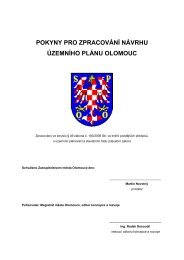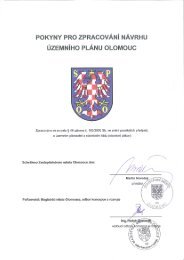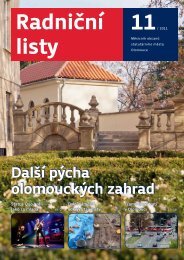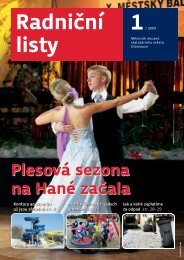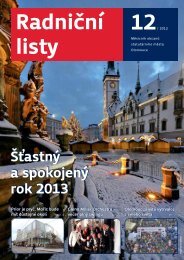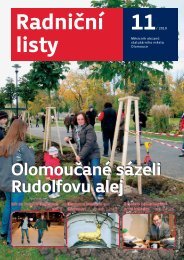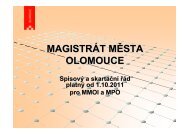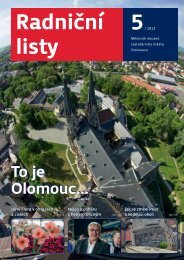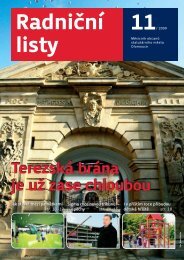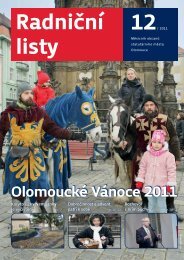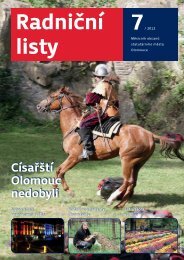Astronomical clock - Olomouc
Astronomical clock - Olomouc
Astronomical clock - Olomouc
You also want an ePaper? Increase the reach of your titles
YUMPU automatically turns print PDFs into web optimized ePapers that Google loves.
ASTRONOMICAL CLOCK<br />
The celebrated <strong>Olomouc</strong> <strong>Astronomical</strong> Clock is a major component<br />
of the northern façade of the Town Hall. It is set into<br />
a lancet arched bay recess which reaches the not unsubstantial<br />
height of nearly fourteen metres. Its current face,<br />
a curiosity in the style of socialist realism, bears no witness<br />
to its long history, its scientifi c qualities, nor to the richness<br />
of the moving fi gures which once accompanied its music<br />
and its charms. Thankfully, archival sources and museum<br />
collections can tell the story of how the astronomical <strong>clock</strong><br />
has fascinated people since the fi fteenth century.<br />
Local legend connects its origin to the years 1419–1422.<br />
Sun indicator<br />
on the astronomic dial<br />
(1573–1575).<br />
Planisphere by Pavel Fabricius<br />
(1573–1575).<br />
Baroque indicator of the<br />
phases of the moon (1746).<br />
Moon indicator<br />
on the astronomic dial<br />
(1573–1575).<br />
Modern research on the process of the Olo mouc Town Hall<br />
construction puts the origin of the astronomical <strong>clock</strong> alcove<br />
in conjunction with extension of the late-Gothic reconstruction<br />
which began in 1474, but the fi rst certain record of its existence<br />
dates from 1519. The original <strong>clock</strong> (the appearance<br />
of its face is unknown) was “renewed and improved” during<br />
the fi rst large-scale renovations in the years 1573–1575.<br />
Participating Pozdně in gotická this project kroužená were klen- a man of letters (an astronomer<br />
– the ba eminent presbytáře Vienna v radniční University kapli. professor and personal<br />
astrologer to Emperor Maximillian II, Pavel Fabricius) and a<br />
craftsman (a <strong>clock</strong> maker – <strong>Olomouc</strong> <strong>clock</strong>maker Hans Pohl).<br />
The astronomical <strong>clock</strong> at that time was a visual demonstration<br />
of the medieval scheme of the universe, housed in the<br />
form of a gothic winged shrine with sculptures and paintings.<br />
It contained fi gures which mov ed in time to musical and<br />
percussive mechanisms, and featured paintings on woo den<br />
panels. The universe was depicted as having three spheres:<br />
the lowermost being the calendar dial (earthly sphere), above<br />
this the astronomical/astrological dial (celestial sphere), and<br />
above that sculptures of cherubim with tiny hammers which<br />
beat upon a carillon (the heavenly sphere).<br />
The Thirty Years’ War affected the astronomical <strong>clock</strong> as it<br />
did the rest of the city. The job of its next rebuilding, in the<br />
years 1661–1662, was taken up by the mechanic Martin<br />
Kelbl, the <strong>clock</strong>maker František Jahn, and Antonín Gerhard<br />
– a Jesuit, mathematician, and expert in things astronomical.<br />
At that time renovations concerned with enriching the paint-<br />
ing elements of the <strong>clock</strong> concentrated on murals depicting<br />
the Seven Liberal Arts on the interior surfaces of the arch.<br />
The lower part of the <strong>clock</strong> still contained Fabricius’s indicating<br />
dials with four smaller indicators on the sides. Their<br />
dials indicated the quarters, hours, planets and red-letter<br />
days and “non-equal” hours. The day of the year was indicated<br />
by an angel on the lower calendar dial. In the central<br />
portion of the <strong>clock</strong> was the carillon, above which was<br />
a royal portrait and at the same level a reclining sculpture<br />
of the goddess Luna. The side “wings” of the <strong>clock</strong> were<br />
animat ed by a set of mechanical marionettes. On the left<br />
was St. Wenceslas, around whom St. George on horseback<br />
pursued a retreating dragon. Above them, while the hours<br />
were rung, a monk fi ngered a rosary and an anchorite<br />
pulled a bell-rope. The right side portrayed the Madonna<br />
and Child below, circled and adored by the Three Magi.<br />
Above this group was a Renaissance cavalier performing<br />
the function of a bell-ringer, accompanied by a trumpeter.<br />
The last major renovation of the astronomical <strong>clock</strong> in its<br />
original form (based on its conviction that the sun and<br />
planets revolved around the Earth) occurred in the years<br />
1746–1747. Again a <strong>clock</strong>maker and organmaker came<br />
into play, as well as the most famous painter to work on<br />
the astronomical <strong>clock</strong> to this day, the <strong>Olomouc</strong> Baroque<br />
painter Jan Kryštof Handke. For his paintings for the interior<br />
faces of the alcove walls, Handke kept to the motif of the<br />
Moving Renaissance<br />
bell-ringer fi gure<br />
(1573–1575).<br />
“Depiction of the artistic <strong>clock</strong> of <strong>Olomouc</strong> Town Hall at its fi nest<br />
condition in the year 1747”. Watercolour by J. W. Fischer (1805).<br />
Seven Liberal Arts, a choice deferring to the celebration<br />
of the natural sciences – Arithmetic, Geometry, Astronomy,<br />
and Music. Belonging to these are also Grammar, Rhetoric,<br />
and Logic. Handke added a fi nal allegory to these to make<br />
a round eight – Industry, the essential condition for success<br />
in any fi eld. Below on the frontal portion Handke (with great<br />
self-confi dence) painted a <strong>clock</strong>maker and a painter as the<br />
two main fi gures, which can be considered accurate depictions<br />
of the two masters themselves.



